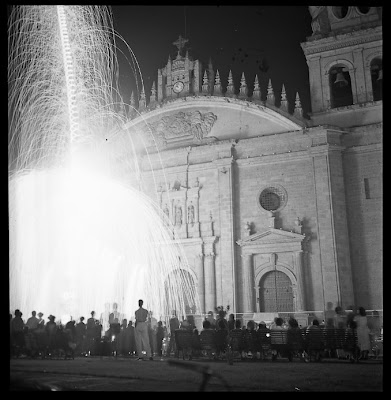
Back to Guadalajara in 1953: Fireworks in front of the cathedral for the Fiesta of the Virgin of Zapopan. Just a few blocks from here, my exhibit of this and other of the photographs was to take place in 2008, in the month of May.
Right after I took this picture, I fell ill. Dysentary, probably from eating the oysters back outside of Mazatlan. Since we were camping on the roadside outside of the city in what was then open country to the North, my companions, Fred and the Mexican hitchhikers, left me there the next day at my insistence. I said "Go back into Guadalajara and enjoy the paseo on Sunday," since in those days young couples strolled around the square in front of and beside the cathedral to see one another and perhaps meet, in the style of 19th century Spain. I said "Come back tonight and I'll probably feel better."
So they left me on a cot, well off the highway at the edge of a cleared area left by road crews. I did not think I would be noticed by cars whizzing past. Next to the cot were a canteen of water and two rolls of toilet paper for my frequent rushes into the nearby bush.
As I lay there, I noticed one car slow down and a family inside studying me. It must have been an odd sight, but one that told its own story fairly clearly. A few hours later, the same car came back from its excursion and pulled into the clearing. A woman and her grown son and daughter were in the car. The woman got out to speak with me. I had enough high-school Spanish to explain my situation.
She said "You will not be better by tonight. You will not be better for a week. Have your friends bring you to our home in Guadalajara, and we will give you a room to sleep in and proper food to see that you recover and can resume your trip soon." She gave me her address, and drove away.










